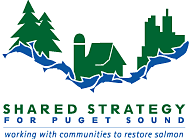|
Turning the Tide for Salmon  Nisqually Delta estuary restoration to benefit Chinook salmon and other Puget Sound wildlife On a cold autumn afternoon on October 31, Nisqually tribal members and hundreds of others welcomed an ancient incoming tide to the Nisqually River estuary. Gathered together on the edge of the shoreline they witnessed the return of 100 acres of natural tidal marsh that has been diked pasture land since the late 1800s. The removal of the dikes on the farmland, once owned and worked by the Braget family, opens up valuable estuarine habitat for endangered Chinook salmon and other wildlife. Dressed in traditional garb, tribal dancers, drummers and singers opened the ceremony as the tide slowly inundated the 100-acre former pasture land. Participants at the event — including politicians, environmental activists and government agency workers — gathered at the edge of the estuary to partake in the Welcoming of the Tides ceremony and to pay tribute to the restoration project’s important contribution to salmon and protection of Puget Sound health. Returning the former cattle land to salt marsh, marks the second and largest phase of the Nisqually Tribes’ efforts to restore the estuary in the Delta — a move that is considered one of the most important steps to restoring Chinook salmon in the Nisqually watershed and is expected to have a regional impact on juvenile salmon from Southern and Central Puget Sound that also use the estuary for habitat. “This estuary is one step of the many steps we need to take to cleanup Puget Sound,” said Billy Frank, Jr. Nisqually tribal elder and chairman of the Northwest Indian Fisheries Commission who spoke at the event. Taking aim at the need to better manage our watersheds and the overall health of Puget Sound, Frank pointed to the “commitment and leadership” behind restoration projects such as the Nisqually River estuary and its example for Puget Sound cleanup. “We’re all in this together,” said Frank who reminded the gathering that it takes many actions, “many little things” to add up to a big impact. The ceremony marked the completion of one of ‘many little things’ that will soon add up to a very big impact — an 850-acre restoration on the Nisqually River estuary and the biggest estuary restoration project in the Pacific Northwest to date. Work will begin next year to remove tidal barriers on the Nisqually National Wildlife Refuge adding 700 acres of reclaimed estuary to the Nisqually Delta. Once the restoration project is completed, 85 percent of the historic Nisqually estuary will be intact. State Ecology director Jay Manning acknowledged the enormous significance of the project and its contribution to preserving estuary habitat. “Estuaries may be the single most endangered habitat in Puget Sound. I hope we can replicate this as we restore Puget Sound,” said Manning, who is also co-chair of the Puget Sound Partnership, a group charged by Governor Gregoire to cleanup Puget Sound by 2020. Among the most bountiful ecosystems in the world, estuaries are considered critical to salmon recovery and preserving the health of Puget Sound. These shallow water shorelines where the river meets the sea help sustain an intricate web of life, purifying the water, helping to prevent floods and providing vital rearing habitat for juvenile salmon. The restoration work in the Nisqually estuary is estimated to result in the doubling of naturally spawning Chinook salmon populations in that watershed. Current estimates calculate that Puget Sound has lost over 70 percent of its tidal wetlands to filling, dredging and diking. This has made restoring these tidal wetlands a priority for the restoration efforts aimed at preserving and protecting salmon and the health of Puget Sound, said Bill Ruckelshaus, chair of the Salmon Recovery Funding Board. “The focus is about life itself,” said U.S. Rep. Adam Smith, D-Washington. “This relationship makes for community and helps to balance out development. We focus on environmental protection to focus on life. We are a part of it.” -p. chambers, Shared Strategy for Puget Sound |
||||||||||||||||||||




